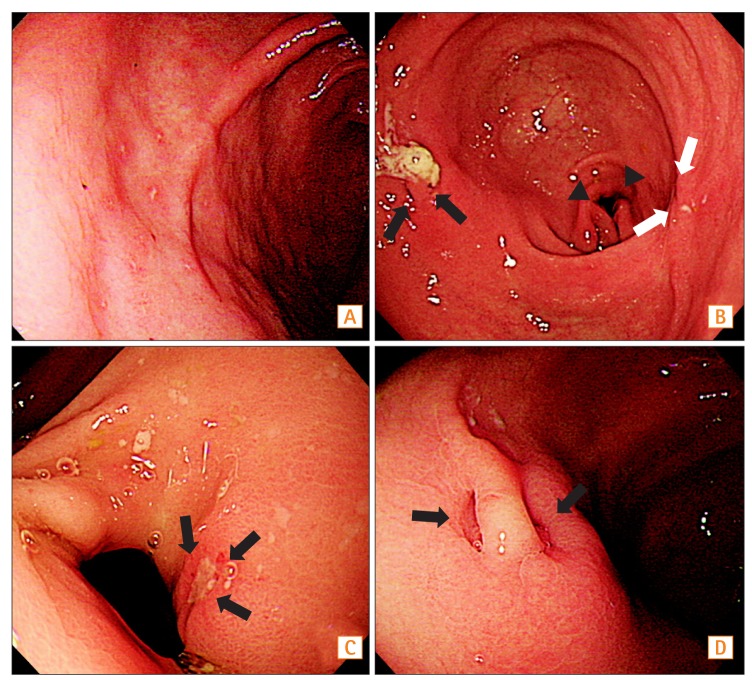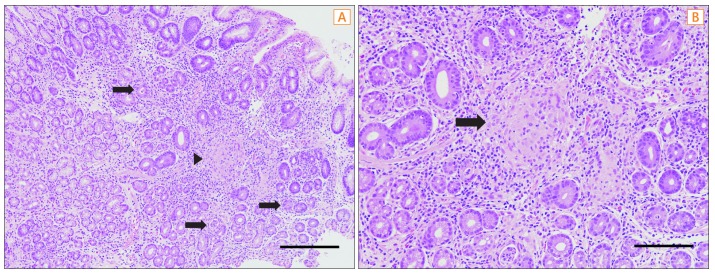Intest Res.
2016 Jan;14(1):60-68. 10.5217/ir.2016.14.1.60.
Gastric lesions in patients with Crohn's disease in Korea: a multicenter study
- Affiliations
-
- 1Department of Gastroenterology, University of Ulsan College of Medicine, Asan Medical Center, Seoul, Korea. bdye@amc.seoul.kr
- 2Inflammatory Bowel Disease Center, University of Ulsan College of Medicine, Asan Medical Center, Seoul, Korea.
- 3Department of Pathology, University of Ulsan College of Medicine, Asan Medical Center, Seoul, Korea.
- 4Department of Internal Medicine, Seoul National University College of Medicine, Seoul, Korea.
- 5Department of Internal Medicine, Kosin University College of Medicine, Busan, Korea.
- 6Department of Internal Medicine, The Catholic University of Korea, St. Vincent's Hospital, Suwon, Korea.
- 7Department of Internal Medicine, Inje University College of Medicine, Seoul Paik Hospital, Seoul, Korea.
- 8Department of Internal Medicine, Institute of Digestive Disease and Nutrition, Korea University College of Medicine, Seoul, Korea.
- 9Department of Internal Medicine, Ewha Womans University School of Medicine, Ewha Mokdong Hospital, Seoul, Korea.
- 10Department of Internal Medicine, Yeungnam University College of Medicine, Daegu, Korea.
- 11Department of Internal Medicine, Keimyung University School of Medicine, Daegu, Korea.
- 12Department of Internal Medicine, Kyung Hee University School of Medicine, Seoul, Korea.
- 13Department of Internal Medicine and Institute of Gastroenterology, Yonsei University College of Medicine, Seoul, Korea.
- 14Department of Internal Medicine, Korea University College of Medicine, Korea University Ansan Hospital, Ansan, Korea.
- 15Department of Internal Medicine, Chung-Ang University College of Medicine, Seoul, Korea.
- 16Department of Internal Medicine, Dankook University College of Medicine, Cheonan, Korea.
- 17Department of Internal Medicine, The Catholic University of Korea, Seoul St. Mary's Hospital, Seoul, Korea.
- 18Department of Internal Medicine, Konyang University College of Medicine, Daejeon, Korea.
- 19Department of Internal Medicine, Sungkyunkwan University School of Medicine, Seoul, Korea.
- 20Department of Internal Medicine, Chonnam National University Medical School, Gwangju, Korea.
- 21Department of Internal Medicine, Eulji University School of Medicine, Seoul, Korea.
- 22Department of Internal Medicine, Hanyang University College of Medicine, Hanyang University Guri Hospital, Guri, Korea.
- KMID: 2174511
- DOI: http://doi.org/10.5217/ir.2016.14.1.60
Abstract
- BACKGROUND/AIMS
Gastric pathology and Helicobacter pylori (H. pylori) infection among Asian patients with Crohn's disease (CD) are still unclear. We evaluated gastric histologic features and frequency of H. pylori infection in Korean patients with CD.
METHODS
Among 492 patients with CD receiving upper gastrointestinal (GI) endoscopic evaluation in 19 Korean hospitals, we evaluated the endoscopic findings and gastric histopathologic features of 47 patients for our study. Histopathologic classification was performed using gastric biopsy tissues, and H. pylori infection was determined using the rapid urease test and histology.
RESULTS
There were 36 men (76.6%), and the median age of patients at the time of upper GI endoscopy was 23.8 years (range, 14.2-60.5). For CD phenotype, ileocolonic disease was observed in 38 patients (80.9%), and non-stricturing, non-penetrating disease in 31 patients (66.0%). Twenty-eight patients (59.6%) complained of upper GI symptoms. Erosive gastritis was the most common gross gastric feature (66.0%). Histopathologically, H. pylori-negative chronic active gastritis (38.3%) was the most frequent finding. H. pylori testing was positive in 11 patients (23.4%), and gastric noncaseating granulomata were detected in 4 patients (8.5%). Gastric noncaseating granuloma showed a statistically significant association with perianal abscess/fistula (P=0.0496).
CONCLUSIONS
H. pylori-negative chronic active gastritis appears to be frequent among Korean patients with CD. The frequency of H. pylori infection was comparable with previous studies. An association with perianal complications suggests a prognostic value for gastric noncaseating granuloma in patients with CD.
Keyword
MeSH Terms
Figure
Cited by 2 articles
-
Characteristics of Upper Gastrointestinal Tract Involvement in Korean Pediatric Crohn's Disease: A Multicenter Study
Ji Hyoung Park, Hye Na Nam, Ji-Hyuk Lee, Jeana Hong, Dae Yong Yi, Eell Ryoo, In Sang Jeon, Hann Tchah
Pediatr Gastroenterol Hepatol Nutr. 2017;20(4):227-235. doi: 10.5223/pghn.2017.20.4.227.Endoscopic Bamboo Joint-like Appearance of the Stomach in Crohn's Disease
Kwang Il Seo, Won Moon
Korean J Gastroenterol. 2017;69(2):151-154. doi: 10.4166/kjg.2017.69.2.151.
Reference
-
1. Turner D, Griffiths AM. Esophageal, gastric, and duodenal manifestations of IBD and the role of upper endoscopy in IBD diagnosis. Curr Gastroenterol Rep. 2009; 11:234–237. PMID: 19463224.
Article2. Korelitz BI, Waye JD, Kreuning J, et al. Crohn's disease in endoscopic biopsies of the gastric antrum and duodenum. Am J Gastroenterol. 1981; 76:103–109. PMID: 7304545.3. Cameron DJ. Upper and lower gastrointestinal endoscopy in children and adolescents with Crohn's disease: a prospective study. J Gastroenterol Hepatol. 1991; 6:355–358. PMID: 1912443.
Article4. Halme L, Kärkkäinen P, Rautelin H, Kosunen TU, Sipponen P. High frequency of helicobacter negative gastritis in patients with Crohn's disease. Gut. 1996; 38:379–383. PMID: 8675090.
Article5. Sonnenberg A, Melton SD, Genta RM. Frequent occurrence of gastritis and duodenitis in patients with inflammatory bowel disease. Inflamm Bowel Dis. 2011; 17:39–44. PMID: 20848539.
Article6. Genta RM, Sonnenberg A. Non-Helicobacter pylori gastritis is common among paediatric patients with inflammatory bowel disease. Aliment Pharmacol Ther. 2012; 35:1310–1316.
Article7. el-Omar E, Penman I, Cruikshank G, et al. Low prevalence of Helicobacter pylori in inflammatory bowel disease: association with sulphasalazine. Gut. 1994; 35:1385–1388. PMID: 7959192.
Article8. Mantzaris GJ, Archavlis E, Zografos C, Zavos K, Petraki K, Triadaphyllou G. Low prevalence of Helicobacter pylori in inflammatory bowel disease: association with sulfasalazine. Am J Gastroenterol. 1995; 90:1900. PMID: 7572928.9. Wagtmans MJ, Witte AM, Taylor DR, et al. Low seroprevalence of Helicobacter pylori antibodies in historical sera of patients with Crohn's disease. Scand J Gastroenterol. 1997; 32:712–718. PMID: 9246713.
Article10. Meining A, Bayerdörffer E, Bastlein E, et al. Focal inflammatory infiltrations in gastric biopsy specimens are suggestive of Crohn's disease. Crohn's Disease Study Group, Germany. Scand J Gastroenterol. 1997; 32:813–818. PMID: 9282974.
Article11. Parente F, Molteni P, Bollani S, et al. Prevalence of Helicobacter pylori infection and related upper gastrointestinal lesions in patients with inflammatory bowel diseases. A cross-sectional study with matching. Scand J Gastroenterol. 1997; 32:1140–1146. PMID: 9399396.
Article12. Parente F, Cucino C, Bollani S, et al. Focal gastric inflammatory infiltrates in inflammatory bowel diseases: prevalence, immunohistochemical characteristics, and diagnostic role. Am J Gastroenterol. 2000; 95:705–711. PMID: 10710061.
Article13. Väre PO, Heikius B, Silvennoinen JA, et al. Seroprevalence of Helicobacter pylori infection in inflammatory bowel disease: is Helicobacter pylori infection a protective factor? Scand J Gastroenterol. 2001; 36:1295–1300. PMID: 11761020.14. Guslandi M, Fanti L, Testoni PA. Helicobacter pylori seroprevalence in Crohn's disease: lack of influence by pharmacological treatment. Hepatogastroenterology. 2002; 49:1296–1297. PMID: 12239929.15. Triantafillidis JK, Gikas A, Apostolidiss N, Merikas E, Mallass E, Peros G. The low prevalence of helicobacter infection in patients with inflammatory bowel disease could be attributed to previous antibiotic treatment. Am J Gastroenterol. 2003; 98:1213–1214. PMID: 12809861.
Article16. Prónai L, Schandl L, Orosz Z, Magyar P, Tulassay Z. Lower prevalence of Helicobacter pylori infection in patients with inflammatory bowel disease but not with chronic obstructive pulmonary disease - antibiotic use in the history does not play a significant role. Helicobacter. 2004; 9:278–283. PMID: 15165265.
Article17. Sładek M, Jedynak-Wasowicz U, Wedrychowicz A, Kowalska-Duplaga K, Pieczarkowski S, Fyderek K. The low prevalence of Helicobacter pylori gastritis in newly diagnosed inflammatory bowel disease children and adolescent. Przegl Lek. 2007; 64(Suppl 3):65–67. PMID: 18431918.18. Yao T, Matsui T, Hiwatashi N. Crohn's disease in Japan: diagnostic criteria and epidemiology. Dis Colon Rectum. 2000; 43(Suppl 10):S85–S93. PMID: 11052483.19. Yang SK, Yun S, Kim JH, et al. Epidemiology of inflammatory bowel disease in the Songpa-Kangdong district, Seoul, Korea, 1986-2005: a KASID study. Inflamm Bowel Dis. 2008; 14:542–549. PMID: 17941073.
Article20. Thia KT, Loftus EV Jr, Sandborn WJ, Yang SK. An update on the epidemiology of inflammatory bowel disease in Asia. Am J Gastroenterol. 2008; 103:3167–3182. PMID: 19086963.
Article21. Chuang CH, Lin SH, Chen CY, Sheu BS, Kao AW, Wang JD. Increasing incidence and lifetime risk of inflammatory bowel disease in Taiwan: a nationwide study in a low-endemic area 1998-2010. Inflamm Bowel Dis. 2013; 19:2815–2819. PMID: 24141711.
Article22. Park SH, Yang SK, Park SK, et al. Long-term prognosis of Crohn's disease and its temporal change between 1981 and 2012: a hospital-based cohort study from Korea. Inflamm Bowel Dis. 2014; 20:488–494. PMID: 24412992.
Article23. Ng SC, Tsoi KK, Kamm MA, et al. Genetics of inflammatory bowel disease in Asia: systematic review and meta-analysis. Inflamm Bowel Dis. 2012; 18:1164–1176. PMID: 21887729.
Article24. Loftus EV Jr, Silverstein MD, Sandborn WJ, Tremaine WJ, Harmsen WS, Zinsmeister AR. Crohn's disease in Olmsted County, Minnesota, 1940-1993: incidence, prevalence, and survival. Gastroenterology. 1998; 114:1161–1168. PMID: 9609752.
Article25. Satsangi J, Silverberg MS, Vermeire S, Colombel JF. The Montreal classification of inflammatory bowel disease: controversies, consensus, and implications. Gut. 2006; 55:749–753. PMID: 16698746.
Article26. Best WR, Becktel JM, Singleton JW, Kern F Jr. Development of a Crohn's disease activity index. National Cooperative Crohn's Disease Study. Gastroenterology. 1976; 70:439–444. PMID: 1248701.27. Sostegni R, Daperno M, Scaglione N, Lavagna A, Rocca R, Pera A. Review article: Crohn's disease: monitoring disease activity. Aliment Pharmacol Ther. 2003; 17(Suppl 2):11–17. PMID: 12786607.28. Park HK, Kim N, Lee SW, et al. The distribution of endoscopic gastritis in 25,536 heath check-up subjects in Korea. Korean J Helicobacter Up Gastrointest Res. 2012; 12:237–243.29. Van Assche G, Dignass A, Panes J, et al. The second European evidence-based Consensus on the diagnosis and management of Crohn's disease: Definitions and diagnosis. J Crohns Colitis. 2010; 4:7–27. PMID: 21122488.
Article30. Hasni SA. Role of Helicobacter pylori infection in autoimmune diseases. Curr Opin Rheumatol. 2012; 24:429–434. PMID: 22617822.31. Chen Y, Blaser MJ. Helicobacter pylori colonization is inversely associated with childhood asthma. J Infect Dis. 2008; 198:553–560. PMID: 18598192.
Article32. Reibman J, Marmor M, Filner J, et al. Asthma is inversely associated with Helicobacter pylori status in an urban population. PLoS One. 2008; 3:e4060. DOI: 10.1371/journal.pone.0004060. PMID: 19112508.33. Luther J, Dave M, Higgins PD, Kao JY. Association between Helicobacter pylori infection and inflammatory bowel disease: a meta-analysis and systematic review of the literature. Inflamm Bowel Dis. 2010; 16:1077–1084. PMID: 19760778.
Article34. Furusu H, Murase K, Nishida Y, et al. Accumulation of mast cells and macrophages in focal active gastritis of patients with Crohn's disease. Hepatogastroenterology. 2002; 49:639–643. PMID: 12063959.35. Song MJ, Park DI, Hwang SJ, et al. The Prevalence of Helicobacter pylori Infection in Korean Patients with Inflammatory Bowel Disease, a Multicenter Study. Korean J Gastroenterol. 2009; 53:341–347. PMID: 19556840.
Article36. Yamamoto T. Prevention of recurrence after surgery for Crohn's disease: efficacy of infliximab. World J Gastroenterol. 2010; 16:5405–5410. PMID: 21086556.
Article37. Simillis C, Jacovides M, Reese GE, Yamamoto T, Tekkis PP. Meta-analysis of the role of granulomas in the recurrence of Crohn disease. Dis Colon Rectum. 2010; 53:177–185. PMID: 20087093.
Article38. Kotze PG, Saad-Hossne R. Biological therapy for the prevention and treatment of postoperative endoscopic recurrence in Crohn's disease: time for acceptance? Intest Res. 2013; 11:256–260.
Article39. Denoya P, Canedo J, Berho M, et al. Granulomas in Crohn's disease: does progression through the bowel layers affect presentation or predict recurrence? Colorectal Dis. 2011; 13:1142–1147. PMID: 20860713.
Article40. Markowitz J, Kahn E, Daum F. Prognostic significance of epithelioid granulomas found in rectosigmoid biopsies at the initial presentation of pediatric Crohn's disease. J Pediatr Gastroenterol Nutr. 1989; 9:182–186. PMID: 2809938.
Article41. De Matos V, Russo PA, Cohen AB, Mamula P, Baldassano RN, Piccoli DA. Frequency and clinical correlations of granulomas in children with Crohn disease. J Pediatr Gastroenterol Nutr. 2008; 46:392–398. PMID: 18367950.
Article42. Wagtmans MJ, van Hogezand RA, Griffioen G, Verspaget HW, Lamers CB. Crohn's disease of the upper gastrointestinal tract. Neth J Med. 1997; 50:S2–S7. PMID: 9050325.
Article43. Loftus EV Jr. Upper gastrointestinal tract Crohn's disease. Clin Perspect Gastroenterol. 2002; 5:188–191.
- Full Text Links
- Actions
-
Cited
- CITED
-
- Close
- Share
- Similar articles
-
- Isolated Duodenal Crohn's Disease: A case report
- Isolated Crohn's Disease of Stomach A case report and review of the literature
- A Case of Crohn's Disease Showing a Skin Lesion with a Cobblestone-like Appearance in the Perianal Region
- Prevention of Post-operative Recurrence in Crohn's Disease
- Crohn's Disease with Oral and Tonsillar Ulceration



